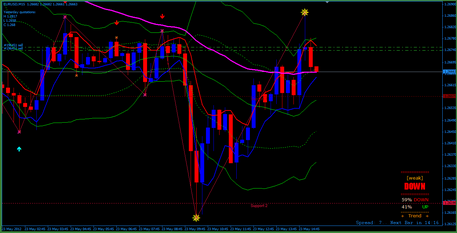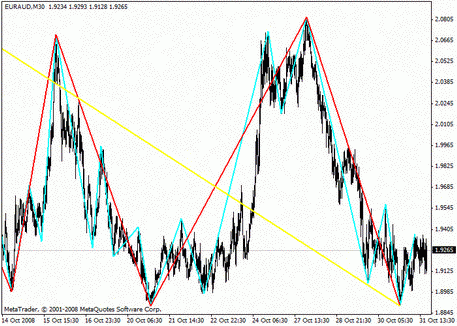
Elliott Wave Theory
Thursday, 24 August 2017 03:50
Elliott Wave Theory describes the behavior of market participants, as well as their influence on the prices of indexes and currency pairs. According to Ralph Nelson Elliott, the price fluctuations on the market can be described with the wave dynamics.
Robert Prechter made such a theory popular. With the help of such a method, he predicted the largest collapse of the Dow Jones index on October 2, 1987. This incident was called "Black Friday." The index fell by 34%.
Basic Wave Principles
According to the system, any behavior of an asset can be represented in the form of a fractal wave of eight steps. The primary task, therefore, is the identification of such steps on the price chart. Then it becomes possible to provide an accurate forecast of the price behavior in the future.
Every increase in the traders’ activity has three steps, and each descent has two phases. Therefore, each Elliott wave consists of four parts, with a wave peak on the third one.
Technical Features of the Elliott Waves
There are two types of the oscillatory motion:
- Impulse is a fluctuation directed towards a higher wave;
- Correction is the oscillation in the opposite direction.
Let's designate the ascending waves as 1, 2, 3, 4 and 5. The descending ones will have letter designations of a, b, and c.

There are three ground rules of the theory:
- The second stage doesn’t fall below the first one;
- The third stage cannot be the smallest one among the 1, 3 and 5;
- The fourth stage doesn’t intersect along the Y axis with the first one.
The following rules are sometimes implemented (but not always):
- If the third pulse is longer than the first and fifth ones, then the first wave is approximately equal to the fifth one;
- The inclinations of the second and fourth correctional oscillations are different: if the second wave is sloping, then the fourth wave is steep, and vice versa;
- The a, b, and c waves don’t drop below the start point of the fifth one.
All the elements are fractal, that is, they consist of the smaller parts. In this case, their number is described by the Fibonacci numbers. The complete cycle consists of two large waves, eight medium ones, 34 small ones, and so on.

Also, Fibonacci numbers determine the duration of each movement. According to Mr. Elliott, if the price moves in a particular direction for more than three days, then it won’t turn earlier than five days later. If the trend continues for five days, it won’t turn sooner than in 8 days. The nine-day trend will last at least 13 days, etc. At the same time, Mr. Elliott noted that such a move is considered ideal, and not always implemented in practice.
Trading with the Elliott Theory
First, it’s worth noting that all the figures on the price chart are subdivided into many types of oscillations, such as zigzag, triangular, and range ones. The depth of each fluctuation must depend on others, expressed in Fibonacci numbers. A thorough study of Elliott's theory requires a quite serious preparation, as well as advanced mathematical skills. Making the wrong subjective interpretation of the price fluctuations, you can quickly form a false forecast, which entails losing trades.
Nevertheless, this approach is used by many traders, as an opportunity to identify the direction of the trend, to predict the further movement of the asset, and to assess the strength and period of the impulses.
In general, the trading process looks as follows:
- The first wave is relatively weak. When it reaches the peak, traders fix the profit, and wait for the correction wave;
- Short trades are open at the beginning of the second wave. At this stage, the bears often leave the market, and then the bulls come in;
- The third stage is for purchase, with a stop loss set at the low point;
- New correction comes;
- At the fifth stage, many traders open the buy position. A price peak forms. Positions are closed at the end of the wave, and then the Bears enter the market.
Summary
The Elliott’s theory is quite controversial among the market participants, and many traders disagree with it. A beginner should study all the features of such an approach carefully, which requires much time and efforts.
To make the trading process easier, you can set up the Elliott indicators that perform most analytical tasks automatically. Such tools will save you from the cumbersome mathematical calculations.
Don’t use the method in a real trade immediately. Practice on demo accounts first, to be sure of the quality of the skills learned.
Share
Related articles
- Previous article: Forex Market Volatility
- Next article: The Uptrend

 English
English
 русский
русский



